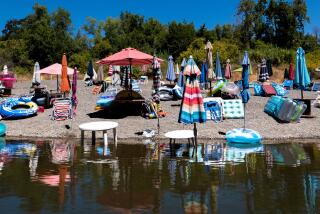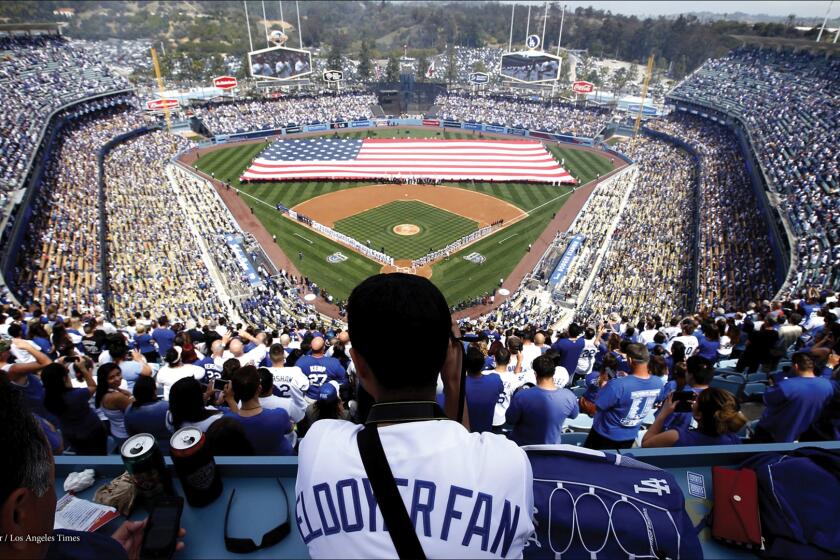In ‘Whites Only’ Era, an Oasis for L.A.’s Blacks
- Share via
When 17-year-old Verna Deckard and her fiance, 21-year-old Arthur Lewis, visited Santa Monica in 1924, Inkwell Beach was the only place they could spread a blanket.
“All the rest of the beach ... you couldn’t go there unless you belonged to a club, and we couldn’t belong to a club” because of racial restrictions, she recalled in a four-hour interview for the Los Angeles Public Library’s Shades of L.A. project, which was taped before Verna Deckard Lewis Williams, as she later became, died in 1998.
During the 1920s, Inkwell was an oasis for African American beachgoers -- the only part of the sand they were allowed to set foot on, except, briefly, for a small section of Manhattan Beach. The 200-foot-long roped-off area at the foot of Pico Boulevard was marked “for Negroes only.” Although racial restrictions on public beaches were invalidated by the courts in 1927 and generally disappeared by the 1930s, blacks continued to call Inkwell their own through the early 1950s.
The impetus for Inkwell came when a young black chauffeur named Arthur Valentine and his family and friends brazenly settled on a section of the “whites only” beach for Santa Monica’s Memorial Day festivities in 1920. Three police officers ordered them to leave.
When the group refused, one officer picked up and “tossed aside a small black child who got in their way,” Douglas Flamming wrote in “Bound for Freedom: Black Los Angeles in Jim Crow America,” a book published in 2005. The police beat Valentine and then shot him, Flamming wrote.
When Valentine filed a complaint, the authorities charged him with assault with a deadly weapon. If he had had a weapon, historical records do not indicate what it was.
The Los Angeles County Civil Service Commission had the power to investigate Valentine’s complaint but refused because of the charges against him. He turned to Los Angeles Dist. Atty. Thomas Lee Woolwine, who was highly respected for his unbiased treatment of minorities. Woolwine filed felony assault charges against the officers.
Over the next three years, Flamming wrote, Valentine was assaulted by the police periodically. Woolwine was heckled by the Ku Klux Klan. Finally, the charges against the officers were dismissed for lack of evidence. The charges against Valentine were dropped too.
The incident prompted blacks to claim their own sliver of public beach near the Crystal Plunge, a former open-air swimming pool that had been destroyed by a flood in 1905, then abandoned. The area was a polluted, debris-filled spot that no one else wanted. Around 1922, it became known as Inkwell Beach.
Inkwell offered ocean breezes, swimming, volleyball and a small, black-owned bathhouse called La Bonita, which rented swimsuits to black beachgoers. It was on Pico Boulevard several blocks off the beach.
Williams, who was from Texas, loved Los Angeles because blacks had more freedom here than in the South. “You couldn’t even go to the park in Texas,” she said.
But it was far from perfect. Most black visitors to Inkwell rode in the back of the Big Red Cars along the Pacific Electric trolley lines down Pico Boulevard to Santa Monica Beach. Williams drove her own little Ford, often filled with the “Joy Girls,” her new group of friends.
Since the early 1900s, a black community had thrived near 4th and Bay streets, where the 100-year-old Phillips Chapel CME Church stands today. But coastal land was becoming more valuable and, as Santa Monica’s black population increased, whites’ hostility and racism grew.
In 1922, homeowners formed the Santa Monica Bay Protective League to drive blacks out, according to newspaper coverage at the time. “Settlement of Negroes Is Opposed,” a Times headline read. The group’s agenda, The Times wrote, was “eliminating all objectionable features or anything that now is or will prove a menace to the bay district ... or prove detrimental to our property values.”
Los Angeles Chamber of Commerce President Sylvester L. Weaver Sr. urged fellow chamber directors to stop the sale of private beach in Santa Monica before the public found “the ocean fenced off.” He continued: “In front of where I have a summer residence ... a piece of land has been fenced off and none but colored people allowed. I was born pretty far south to have that in front of my house.”
In actuality, the beach was public; it was merely fenced off, as many other areas were for whites.
Black investors had tried to purchase the adjacent Crystal Plunge site; they were rejected. But in 1924, it was sold to white developers who wanted to build a private beach club and hotel. Even before they broke ground, builders erected fences for the “safety of our members,” The Times reported.
The Italian Renaissance Revival building, designed by architect Charles F. Plummer, became the Club Casa del Mar, opening in 1926. During Prohibition, wealthy white tourists went there for swinging beach parties, dinner dances and illicit gambling and drinking.
Next door, Inkwell patrons reaped the benefits of the fancy hotel by dancing to the tunes of big bands that played at the posh address.
Blacks also played volleyball and took late-night dips in the surf with the help of the hotel’s floodlight system.
Williams remembered once when playing with a beach ball at Inkwell the ball accidentally flew over the fence onto Club Casa Del Mar’s turf.
“When I ran over there to get it, a little old lady comes running up to me saying, ‘You got no business over here.’ And I just looked at her, didn’t say anything. I just took my ball and went back, where I belonged.”
In the early 1920s, developers in Santa Monica and elsewhere put racial restrictions on deeds, barring “Negroes from ownership and occupation” of land.
When Sunday night dances at a black-owned club, George Caldwell’s Dance Hall at Pico Boulevard and 3rd Street, were a little too rowdy, neighbors complained and the city banned dances.
When a group of black investors tried to build a resort, including a bathhouse with beach access and an amusement center, the city denied construction permits.
Property owners pulled the plug on all land sales to black buyers. (The U.S. Supreme Court struck down racial covenants in 1948.)
In 1935, the Pico-Kenter storm drain was built at Inkwell to carry gutter runoff out to sea. The drain remains; it has been a source of pollution over the years.
In the 1940s, Inkwell became home to the first documented black surfer.
Nick Gabaldon, one of about 50 black Santa Monica High School students, was tall, handsome and athletic.
He befriended the nearby lifeguards and, using their 13-foot rescue surfboard, quickly mastered the new sport of “wave riding.”
Nat Trives, 70, remembers Inkwell and the culture that spawned it. Inkwell was where he took his first dip in the ocean when he arrived with his family from Birmingham, Ala., in 1949.
“I may have taken advantage of the beach parking lot to explore the mysteries of lovers’ lane” when attending Santa Monica High School, he said.
Trives is chairman of the Santa Monica Chamber of Commerce, and in 1975, he became the city’s first black mayor.
“There’s no Mason-Dixon line in Santa Monica” today, he said.
More to Read
Sign up for Essential California
The most important California stories and recommendations in your inbox every morning.
You may occasionally receive promotional content from the Los Angeles Times.













